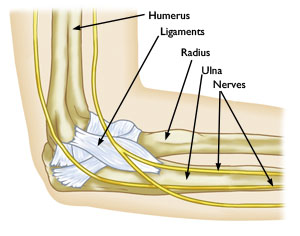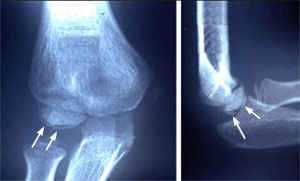
Throwing Injuries in the Elbow in Children
With the start of the baseball season each spring, doctors frequently see an increase in elbow problems in young baseball players. A common elbow problem in these children is medial apophysitis, commonly referred to by doctors as "Little Leaguer's elbow."
AnatomyYour elbow joint is a joint made up of three bones: your upper arm bone (humerus) and the two bones in your forearm (radius and ulna). Muscles, ligaments, and tendons hold the elbow joint together.
The elbow is a combination hinge and pivot joint. The hinge part of the joint lets the arm bend like the hinge of a door; the pivot part lets the lower arm twist and rotate. Several muscles, nerves, and tendons (connective tissues between muscles and bones) cross at the elbow.
 Description
Description
"Little Leaguer's elbow" and osteochondritis dissecans affect pitchers and other players who throw repetitively.
Medial Apophysitis (Little Leaguer's Elbow)
This injury occurs when repetitive throwing creates an excessively strong pull on the tendons and ligaments of the elbow. The young player feels pain at the knobby bump on the inside of the elbow.
"Little Leaguer's elbow" can be serious if it becomes aggravated. Repeated pulling can tear ligaments and tendons away from the bone. The tearing may pull tiny bone fragments with it in the same way a plant takes soil with it when it is uprooted. This can disrupt normal bone growth, resulting in deformity.
Osteochondritis Dissecans
A less common condition called osteochondritis dissecans is also caused by excessive throwing, and may be the source of the pain on the outside of the elbow. Muscles work in pairs. In the elbow, if there is pulling on one side, there is pushing on the other side. As the elbow is compressed, the joint smashes immature bones together. This can loosen or fragment the bone and cartilage. The resulting condition is called osteochondritis dissecans.
 X-rays of the right elbow joint of an 8-year-old baseball pitcher show irregularity of the humerus where it meets the bones of the forearm (see arrows). This irregularity is a side effect of excessive throwing in the immature elbow.
Symptoms
X-rays of the right elbow joint of an 8-year-old baseball pitcher show irregularity of the humerus where it meets the bones of the forearm (see arrows). This irregularity is a side effect of excessive throwing in the immature elbow.
Symptoms
"Little Leaguer's elbow" may cause pain on the inside of the elbow. A child should stop throwing if any of the following symptoms appear:
- Elbow pain
- Restricted range of motion
- Locking of the elbow joint
Left untreated, throwing injuries in the elbow can become complicated conditions.
Nonsurgical Treatment
Younger children tend to respond better to nonsurgical treatments.
- Rest. Continuing to throw may lead to major complications and jeopardize a child's ability to remain active in a sport that requires throwing.
- Apply ice packs to bring down any swelling.
- If pain persists after a few days of complete rest of the affected area, or if pain recurs when throwing is resumed, stop the activity again until the child gets treatment.
- Refine throwing technique.
Surgical Treatment
Surgery is occasionally necessary, especially in girls older than 12 years and boys older than 14 years.
Depending upon a child's injury, surgery may involve removing loose bone fragments, bone grafting, or reattaching a ligament back to the bone.
PreventionThe general guideline for how many pitches a child can safely throw each week is 75 for 8-10 year olds, 100 for 11-12 year olds, and 125 for 13-14 year olds.. This includes both practice and competitive play. To prevent throwing injuries, young pitchers should only play three to four innings each game.
Source: http://orthoinfo.aaos.org/topic.cfm?topic=A00328
